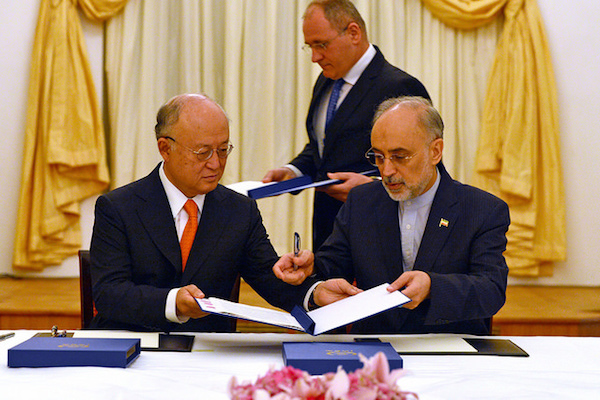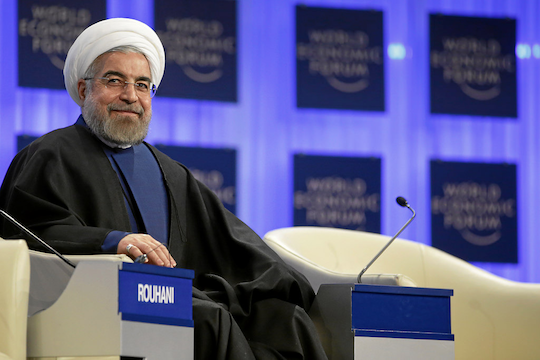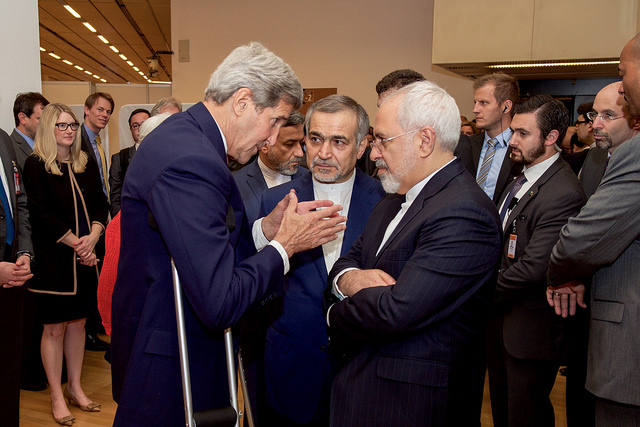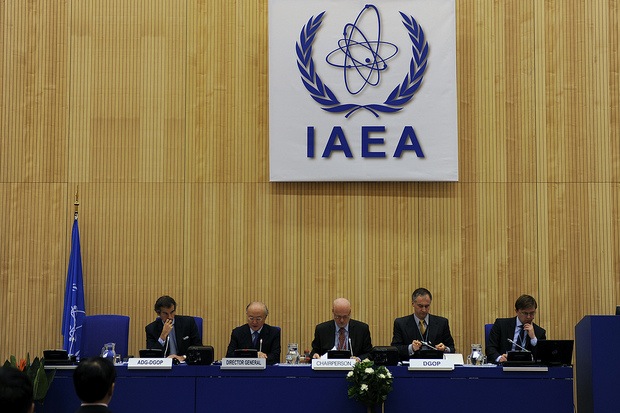Now that the Iran nuclear deal has been implemented, the Islamic Republic, Egypt and others are likely to make a much more serious push for a nuclear-free Middle East. And Israel is in a much tighter spot than ever before.
By Shemuel Meir

A sigh of relief was heard in the corridors of Israel’s security establishment and Prime Minister Netanyahu’s office in May 2015. Its cause: Israel’s success in fending off and foiling a proposed resolution put forward by Egypt at the NPT Review Conference to establish a nuclear-weapon-free Middle East. Prime Minister Netanyahu sent President Obama a special thank you message for having stood by our side and not allowing Israel to be singled out on the nuclear issue. The briefings issued by the Prime Minister’s Office talked about an 11th hour victory.
But nothing lasts forever, and the issue of a nuclear-weapon-free zone (NWFZ) in the Middle East is showing signs of working its way back onto the diplomatic agenda, this time around in the guise of the Comprehensive Nuclear Test Ban Treaty (CTBT).
The U.S., which supports the Helsinki process for the establishment of a nuclear-weapon-free Mideast, was unable, in the spring of 2015, to bridge the gap between Israel and Egypt. The rigid deadline demanded by Egypt (frustrated by past efforts with no time limits) for convening a regional NWFZ conference — March 2016 — was an impassable obstacle for the U.S.
In those days, crucial to sealing the Iran deal, the Obama administration came under a combined attack from Republican senators and AIPAC seeking to thwart the nuclear agreement taking shape. Prime Minister Netanyahu took active part in these efforts to shoot down the deal.
In this belligerent atmosphere, President Obama, could ill afford to open a second front with Israel on the issue of a Mideast NWFZ. The American administration had no choice but to block Egypt’s proposal to convene a NWFZ conference due to the intransigent deadline attached to it, even if that spelled failure for the entire NPT conference. The UK and Canada were the only ones to endorse America’s stand against the rest of the world at the time.
Iran as a champion of non-proliferation?

However, with the Iran deal in place since implementation day in the middle of last month, the Middle East nuclear issue is entering a new world. The new, post-JCPOA Iran is subjected to an intrusive monitoring mechanism blocking its path to nuclear weapons. The agreement has reinstated Iran as a “Non-Nuclear-Weapon State” (NNWS) within the NPT, putting an end to a decade of suspicions and nuclear opacity. At the same time, we have an American administration that was able to get past Senate attacks targeting the deal.
Iran’s pragmatic and less defiant approach to a regional NWFZ was all the more conspicuous compared to Egypt’s traditionally confrontational stance. In President Rouhani’s speeches in the UN and other international fora, Iran was content to send out messages to the U.S. signaling a linkage between its own nuclear agreement and nuclear NWFZ in the Mideast, a relatively moderate message devoid of any demand to establish immediate symmetry between post-deal Iran and Israel.
Iran did not side with Egypt at the May 2015 NPT RevCon, and even showed a willingness to carry on with the brokerage efforts of Finnish facilitator Amb. Laajava to convene the Helsinki Conference (Iran took part in one of the preparatory meetings in Switzerland). Iran’s messages underscored its pioneering role as the first to have come up with the initiative for a Middle East NWFZ as early as 1974. It was a clear signal meant to indicate continuity and consistency in the foreign and security policy of the Islamic Republic of Iran, as well as a clear signal directed at Egypt, to the effect that the primacy and leadership in the Mideast’s nuclear matters were about to change hands.
The new reality was manifested in the public call made by Iranian Minister of Foreign Affairs Zarif to the group of six powers that had formulated the nuclear agreement with Iran: Iran kept its side of the bargain, and now it is your turn to take things up with Israel. His Guardian article outlined the new line envisaged by Iran for a nuclear-weapon-free Middle East: a regional approach as an integral part of overall global efforts to strengthen the nuclear non-proliferation regime, and stronger emphasis on the responsibility and role of the official five nuclear powers in this context. This might be understood as a possible suggestion to apply the multi-lateral negotiation model used by the powers and Iran to the NWFZ in the Middle East as well.
The first global playing field in which the idea of a Middle Eastern NWFZ gets pitched anew might be the CTBT. At the end of January 2016, the CTBT Organization recalled the treaty to the world’s attention at a special symposium held in Vienna to mark the 20th anniversary since signing this treaty on total and absolute ban of nuclear testing.
Notwithstanding the treaty, signed in 1996, the norm against nuclear tests is not a binding ban (although only North Korea has carried out nuclear tests in the 21st century) as long as the treaty is not ratified by eight specific countries. In our region, the treaty must be ratified by Israel, Egypt and Iran in order to entry into force. While Israel and Iran were both actively involved in the talks leading up to the signing of the treaty and are both signatories therein, from its very first day in September 1996, they have yet to present the requisite ratification documents.
Out from under Uncle Sam’s apron

In addition, ratification is also required of the U.S., China, India, Pakistan, Egypt and North Korea if the global treaty banning nuclear testing is to take effect and an on-site inspection mechanism is to be introduced.
To date, Israel was able to enjoy the best of both worlds and hide behind Uncle Sam’s apron and the administration’s inability to push the treaty’s ratification past the Senate by a two-thirds majority. Israel was also able to argue, to the point, that the suspicions surrounding Iran’s nuclear program in the last decade did not allow it to ratify the treaty. But now that the Iran deal has been concluded, circumstances have changed. In the context of the growing interest in the CTBT (an international conference at foreign-minister level is planned in Vienna, as well as a proposed extraordinary meeting of the UN Security Council) and the re-launch of the process to put it into effect, Israel might soon be asked to provide some answers regarding both the ratification of the CTBT and the conference on a NWFZ in the Middle East.
The pressure might come from any number of quarters. Federica Mogherini, head of foreign affairs at the European Union — which played a leading role in reaching the Iran deal — declared that the entry into force of the CTBT would be a top priority from now on.
Recently, after years of stagnation, a rekindled interest in the CTBT ratification can also be observed at upper echelons of the U.S. administration. Undersecretary of State for Arms Control Rose Gottemoeller, during a visit to the National Laboratory for nuclear weapons at Los Alamos, declared how important the ban on nuclear testing was to American national security and how much it contributed to it.
This would seem to imply an American concern of seeing Russian and Chinese commitments to abstain from nuclear testing crumble. According to her, the renewed debate in 2016 is meant to lay the foundations for bringing the CTBT before the Senate for ratification. Obama’s Special Representative on nuclear non-proliferation, Adam Scheinman, talked about the advantages of banning nuclear tests. He said that ratifying the CTBT was “a realistic first step” in reinforcing the nuclear non-proliferation regime (probably against the background of worldwide frustration with the failure of the NPT conference). He admitted that American failure to ratify the treaty was a serious obstacle to its ratification by the other countries that must complete the process in order for the treaty to take effect.
An opportune moment?

With the Iranian nuclear deal in the bag and with a tail wind from the U.S. and the EU (probably in concert with them), Lassina Zerbo, head of the CTBT Organization, has launched a vigorous campaign with a view to reduce the list of eight threshold countries whose ratification is a necessary condition for the treaty to take effect.
Mr. Zerbo has focused most of his efforts and visits on obtaining simultaneous Israeli and Iranian ratification and thus voiding Israel’s argument of being singled out. The guiding idea is to bring silent diplomatic pressure to bear on Israel while commending its contribution to the global verification regime for the detection of nuclear explosions (with dedicated seismic stations near Eilat and on Mount Meron) and to hold simulation workshops on fast detection of violations. At the same time, he pressured Iran to “go the extra mile” and demonstrate good intentions as regards to nuclear energy for peaceful uses after many years of suspicion, by way of a confidence-building measure (CBM) to go along with its nuclear deal.
This initiative, meant to “seize an opportunity” (the Iranian nuclear agreement) in order to get Iran and Israel to ratify the CTBT while concurrently acting within the scope of the nuclear non-proliferation regime, is a novelty in nuclear diplomacy. Here, another argument comes into play that might soon gather momentum: the CTBT as a first step paving the way towards realizing the currently-stuck idea of a NWFZ Middle East.
Simultaneous ratification of the CTBT by Iran and Israel (followed possibly by Egypt) would effectively establish a “nuclear-test-free zone” in the Middle East. After all, their very signature on the treaty amounts to a declaration by Israel, Iran and Egypt of their commitment to honor the treaty’s principles in good faith, namely avoid nuclear tests. Ratification would serve as the most significant confidence-building step en route to a future — be it even far future — establishment of a NWFZ Middle East.
Seen from this angle, Iran is seemingly the weak link, the one to bear the main brunt of pressures and temptations to ratify, as way of leverage to obtaining Israel’s ratification. Iran’s bonus and compensation will lie in taking over the primacy and reins of nuclear processes in the Middle East from Egypt.
How to stop something that doesn’t exist
In the past, Israel knew how to stop NWFZ processes it deemed negative. In light of the new reality following the Iran deal and the renewed interest in getting the CTBT ratified, Israel might find itself once more on the defensive. It had contended with a similar situation in the first half of the 1990s, in the form of a surprise American initiative for regional arms control (as a follow-up measure to the dismantling of Iraq’s unconventional weapons in the first Gulf War) and the urgent American need to push through the 1995 resolution to indefinitely extend the NPT (a move that America was able to pull off then only after accepting Egypt’s condition for a Middle East NWFZ).
In that 1990s episode, Israel was able to extricate itself from its defensive position and pressure thanks to some creative diplomacy displayed by a number of players in the security establishment and through coordination with the U.S., which led to its signing the CTBT and the Chemical Weapons Convention (CWC). This was the first time that Israel played along with the world in the non-proliferation of unconventional weapons.
It would seem today that Israel is once again trying to find a way out by means of a new initiative put forward by Israel’s envoy to the IAEA and its official representative at the symposium marking the 20th anniversary of the CTBT— a “regional moratorium” on nuclear tests, to encompass Israel, Iran and Egypt. Israel believes this to be a confidence-building step that would indicate movement and progress towards ratification of the treaty.
Despite the pretty packaging, however, it is unclear how a proposed “regional moratorium”, which amounts to less than a treaty ratification (and realistically comes in its stead) would lead to the fast ratification required for the CTBT to enter into force. A moratorium involves the stoppage and suspension of activity that is already underway until deciding otherwise; like the moratorium between the five official nuclear powers that had previously carried out nuclear testing, or the one between India and Pakistan, which had carried out nuclear explosions in 1998.
The logic inherent in a call for a moratorium can apply to North Korea, which has carried out four nuclear explosions. It does not make much sense, on the other hand, to declare a regional moratorium in the Middle East on non-existent activity. Thus, proposing a “regional moratorium” contributes no added value to the efforts to promote the ratification of the CTBT.
Ever since signing the peace treaty with Egypt, a nuclear dual has been taking place between Israel and Egypt in international fora. Egypt still maintains regional primacy on the issue of nuclear demilitarization and efforts to subject Israel to the NPT. The Iran deal is about to change the picture as we have known it. Within the hidden dialectic between “the regional solution” for NWFZ (in which Israel has the upper hand as regards the agenda and discussion procedures) and the “global formula” (as these are global issues), the center of gravity might swing in the global direction.
In nuclear diplomacy, the primacy might shift to Iran, and we have already seen indications of that. This represents a new paradigm and new unchartered territory for Israeli diplomacy.
Shemuel Meir is a former IDF analyst and associate researcher at the Jaffee Center for Strategic Studies at Tel Aviv University. Today he is an independent researcher on nuclear and strategic issues and author of the “Strategic Discourse” blog, which appears in Haaretz. A version of this article was first published in Hebrew. Read it here.
